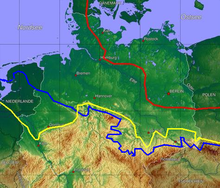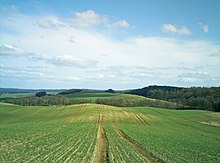Old and young moraine
The terms old moraine and young moraine characterize different types of landscape in formerly glaciated areas of Central Europe. While most of the old moraines still visible today were formed in the Saale Ice Age or Riss Ice Age around 130,000 to 140,000 years ago, or are much older and go back to the Günz Ice Age (600,000 to 800,000 years old), the young moraine landscapes are in Central Europe significantly younger and mostly around 15,000 to 20,000 years old, at least not older than around 100,000 years. The latter emerged in the Vistula Ice Age and in the Alpine glaciation area in the Worm Ice Age . The term old and young moraine is transferred to all elements of the glacial series , even if, strictly speaking, the meltwater deposits and forms do not represent moraines .
Old moraines
The old moraine landscapes were tundras or cold deserts in the last Ice Age . Due to periglacial processes, there was significant erosion (especially denudation , less erosion ) and, on the other hand, the accumulation of sediments in the lowlands. Because of this, the old glacial forms are already clearly blurred and flattened. Furthermore, almost all closed hollow forms (e.g. dead ice kettles and lakes ) are completely filled. The old moraine land is therefore poorer in relief than the young moraine land and has hardly any natural lakes. The river system of the old moraine is normal and hierarchical.
Due to the progressive weathering of the near-surface sediments, the soils are more leached ( browned , decalcified and / or podsolized ). The glacial till is mostly 3–4 meters decalcified, with smaller thicknesses even completely. Frequent forms of removal and accumulation of wind are, since during the cold periods the wind could easily blow sand and silt due to the lack of vegetation cover. Typical of many old moraine areas is therefore the occurrence of wind cutters , dunes and loess .
Young moraines
The young moraine, on the other hand, has fresh glacial forms that can still be easily recognized as such . There are numerous closed hollow forms, many of which are filled with water. The river system is often immature and chaotic. There are numerous inland drainage areas . Wind edges and dunes do occur; however, these forms are much younger and less developed than in the old moraine region. The soils are much less weathered than in the old moraine. On the ground moraine decalcification of is glacial till , therefore, often less than one meter.
Distribution areas in Germany

Young moraine landscapes can be found in the regions that were glaciated in the last Ice Age ( Vistula Ice Age ). These are the regions northeast of the red line, i.e. areas in Brandenburg , Mecklenburg-Western Pomerania , in eastern Schleswig-Holstein and in the northeastern tip of Hamburg. Old moraine landscapes, on the other hand, are only found in those areas that were covered by glaciers in earlier ice ages, but not in the Vistula glaciation. That would potentially be the areas north of the yellow or blue line, i.e. in northern North Rhine-Westphalia , western Schleswig-Holstein, Lower Saxony , Saxony-Anhalt , Thuringia and Saxony . In particular, in nowadays heavily reliefed areas such. B. in Thuringia, the old moraines can hardly be recognized as such in the landscape.
The line of the furthest advancement of glaciers in northern Germany is also known as the flint line. So old moraines can only be found between the red line and the flint line.
literature
- Frank Ahnert: Introduction to Geomorphology . Verlag Eugen Ulmer, Stuttgart 1996, ISBN 3-8252-8103-5 , p. 350 ff .
Web links
- Small glossary on glacial morphology: Moraine: young moraine, old moraine. In: Satellite geography in class, Merzhausen. Central Office for Teaching Media in the Internet eV, accessed on December 10, 2009 .

